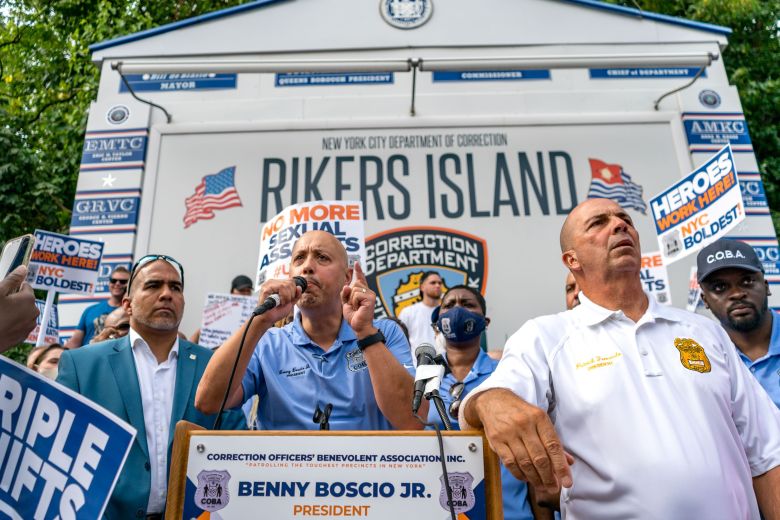City payroll records obtained by THE CITY suggest union enrollment has slipped since a Supreme Court ruling that allows government workers to opt out of membership. Between 2018 and 2022, membership went down nearly 8% among city employee unions, outpacing a decline of 5.1% in the number of full-time employees across city agencies.
The gap has grown since 2019, when the city Independent Budget Office found a 3.5% decline in union dues payers after the decision in Janus v. AFSCME, even as city employment held steady.
THE CITY used employee data compiled by the IBO that shows how many city workers deduct union dues from their paychecks each year, and to which unions. We then compared those numbers against payroll records showing the number of workers in corresponding job titles represented by those unions. Both figures captured the number of workers and the number of dues-paying union members as of the end of each fiscal year, starting June 30, 2019.
For the city’s largest employee union, District Council 37, matching a wide array of job titles with the union they pay dues to wasn’t feasible using publicly available data. But certain jobs are easier to match with their unions — notably police, correction officers, sanitation workers and school personnel.
The Police Benevolent Association shrank by more than 3,100 members between 2019 and 2022, even while the number of cops declined by a smaller 1,300. As the number of correction officers working in the city’s jails declined by one-third, the Correction Officers’ Benevolent Association saw an even greater decline in dues-paying members, with a 40% drop between 2019 and 2022.
The two unions dispute the IBO’s data and THE CITY’s analysis, and each claims the number of workers who have chosen not to pay dues is in the single digits.
The PBA told THE CITY that 21,419 out of 21,423 active police officers are members — and that the remaining four have simply not submitted their paperwork.
“While the Janus decision created more work to get members enrolled in the union, it has not resulted in a diminishment in our membership,” said union spokesperson John Nuthall. “The reduction in our membership is entirely the result of the NYPD’s inability to recruit or retain police officers.”
COBA, which represents the city’s corrections officers, asserts that only three out of the city’s 5,600 correction officers are not paying union dues.
“The Janus decision has had zero impact on our membership,” COBA president Benny Boscio said in a statement. “COBA is very proud of the fact that over 99% of our members are dues paying members, which is a testament to the strength of our union, which continues to fight unprecedented challenges every day, including the worst staffing crisis in decades caused by a three year hiring freeze under the last administration. Any numbers from the IBO that suggest otherwise are patently incorrect.”
One union that is openly acknowledging trouble keeping up its membership is the Professional Staff Congress, representing City University of New York employees — where just half of all part-time staff are currently union members, representing a 10-point drop from pre-Janus levels.
“We have every reason to believe that we can build those numbers back up again,” said union president James Davis.
Benefits Without Costs
Under the Janus decision, public sector workers opt in to paying union dues, and can receive full union benefits even if they are not members. Part-time workers must now re-commit their union membership every time their employment is renewed.
Pre-Janus, public sector employees had the option to explicitly opt out of union membership thanks to an earlier Supreme Court decision but still had to pay “agency fees” out of their paychecks to the unions.
Union leaders, including New York City’s Municipal Labor Committee, warned before the decision of potentially large declines in union membership if signing up became optional.
Any dramatic loss of dues-paying union members could threaten unions’ operations or even their ability to exist – a possibility on the horizon in some so-called “right to work” states.
Harry Nespoli, president of the Uniformed Sanitationmen’s Association IBT Local 831 and chair of the Municipal Labor Committee, said he was not aware of any drop in members among the city’s public sector unions. The Sanitation union’s membership remained steady after the Janus decision and during COVID, THE CITY’s analysis of IBO payroll data shows.
But five years after Janus, he said, there’s only so much unions can do to preserve their membership. He pointed to the sanitation workers he represents, a workforce that has been struggling with looming budget cuts.
“We have to make it better so that they want to join the union. You represent people to the best of your ability – that’s how you fight back,” he added.
As union president, he said, it’s important people know that dropping membership comes at a price: They’ll miss out on certain union-paid benefits and services, such as free legal representation, and they lose their ability to vote in union elections.
As THE CITY previously reported, Census data shows public sector union membership has dramatically slipped among New York City residents, declining from 70% of government workers in 2020 to just 56% in the fiscal year ending in 2023 — a trend highlighted in a recent report by the CUNY School of Labor and Urban Studies.
Ruth Milkman, a lead author of the CUNY report and chair of the school’s graduate labor studies department, said the Janus decision is a “prime suspect” for the decline, when combined with what she described as “extreme challenges involved in reaching out to new employees” during the pandemic. She also pointed to expanded reliance on non-union contracts to perform government work.
Even if no workers opted out, public sector union membership would be declining because of a pandemic-driven drop in government employment. New York City had 282,871 full-time municipal workers as of June 30, 2022, down from 299,853 as of the same date in 2019.
The number of city workers is expected to decline further. In September, Mayor Eric Adams asked city agencies to reduce their spending by 15% as a budget-cutting measure in light of the cost of sheltering thousands of migrants and a rocky fiscal outlook.
Adams also implemented a hiring freeze that went into effect on Oct. 1 — not long after partnering with DC37 and its parent union, the American Federation of State, County and Municipal Employees (AFSCME), to recruit city workers to fill vacant positions.
Remote Work Challenge
Unions say they are working hard to keep membership afloat.
The United Federation of Teachers, which represents 120,000 teachers and school staff, makes its case to new hires during the city Department of Education’s annual orientation for new educators — an opportunity not only to get new hires to sign union cards, but to showcase the “collaborative spirit between labor and management,” said Karen Alford, a vice president at the UFT.
Signing up and keeping union members poses a special challenge for the Professional Staff Congress, which represents staff and faculty at the City University of New York — a workforce with unusually high turnover. Part-timers teach more than 60% of courses at CUNY, with 11,200 part-time faculty — more than the university’s 7,000 full-time instructors.

In many cases, new and returning adjuncts must re-commit their PSC membership each year in order to pay their dues and remain in good standing. That constant churn is “hard to keep up with,” said Davis, who was elected in 2021.
City University of New York employees are not part of city payroll data, so are not included in THE CITY’s analysis. But PSC has seen its membership decline precipitously, numbers shared by the union show — with membership among part-time employees at just 51%, down from 61% pre-Janus, and full-time employees now at 88% union membership, down from 96%.
The first two years of the pandemic saw the steepest decline, as teaching shifted to fully remote, said union president James Davis.
“Certainly when Janus hit, we lost some revenue that we had coming from fee payers, but we have not by and large lost union members because they turned around and said, ‘Gosh, I don’t need to pay my union anymore, I’m going to drop my union membership,’” Davis said.
Rather, the pandemic and remote work — which the PSC championed and successfully expanded — has made it “harder to have membership conversations” with CUNY staff face-to-face, he said, a crucial way to engage new hires and potential members, especially part-time workers.
One CUNY faculty member who has studied government unions says the Census numbers suggest that the effects of Janus are beginning to take hold in New York, even if workers aren’t dropping their unions for ideological reasons.
“You’re seeing a wave of retirements or people moving out, and then those new hires are not picking up union membership — despite the fact that union membership, or the idea of a union, is at an-all time high,” said Daniel DiSalvo, a political science professor at City College who is not a PSC member and author of Government Against Itself: Public Union Power and Its Consequences.
“So that’s kind of an interesting paradox. People say they’re in favor of unions, but when it comes to them choosing to actually become a member, they’re not paying.”




